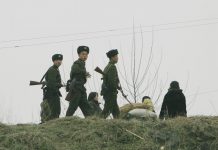Why did the rice price increase from late April to middle of May?
During late April, North Korean food prices rose sharply, in part due to the lack of food. However, a more important cause is that the North Korean authorities simply don’t have the ability to cope effectively with the food crisis.
To explain, since late April food prices have been increasing. In mid-April, the Chinese government suspended food transactions with North Korea because of a lack of food in China. At that time, the ringleaders who raised rice prices inside North Korea were traders in the jangmadang (markets). Upon the suspension of rice imports, traders raised rice prices up to 2,000 won from 1,500 so as to earn extra profits.
On the 17th and 18th of May, the Daily NK met recent defectors being educated in Hanawon. They confirmed that the key cause of the rising rice prices in North Korea is the influence of these traders, who have been able to monopolize the rice trade since last fall. They unanimously say that the attitude of traders is totally different to that of previous ones [before 2003].
Practically then, in North Korean markets a few traders hold a monopoly over food and the necessities of life, so the prices are determined by them.
Due to this, the North Korean authorities moved to ban jangmadang traders from circulating food, through market regulation measures and inspection units. They also put out public announcements that traders were not to raise prices up to 2,000 won. However, these measures resulted in the formation of an oligopoly market, in which a small number of traders can sell rice with great ease, even for 4,000 won, from their homes, because of supply shortages.
The sources from North Korea say that “The rice price has been known to rise by up to 1,000 won in a single day due to market regulation.”
So finally, as the crisis deteriorated, the authorities instructed related governmental organizations not to regulate markets for the time being. In mid-May they withdrew the inspection units.
The rice price bubble
In addition, the rise in rice prices in China, and the subsequent Chinese suspension of exports to North Korea was partially responsible for the increase in North Korean rice prices.
From late September to early October, Chinese rice sold for 900 North Korean won in Hoiryeong, Musan, Hyesan and surrounding areas. At the time, one Yuan was 400 North Korean won, and one kg of rice cost 2.40 Yuan.
However, the value of the Yuan rose and exports of rice to North Korea were suspended; in North Korean border cities one Yuan went up to 480 North Korean won. Additionally, the domestic Chinese rice price rose, so the rice which was sent to North Korea [by smugglers] rose to 3.20 Yuan per kg. At the time, rumors of a food crisis were at their height, and smuggling was thriving in the border areas. In May, the major material for smugglers, copper, was valued at 24,000 won per kg, aluminum 5,000 won, and iron scraps 900 won per kg.
The rice smuggled in from China cost 80 Yuan, which is 37,600 won for a 25kg sack.
Furthermore, the smugglers had to pay 10,000 won bribes to border guards. Then, when the smugglers bring things to domestic traders, 150 won per kg is added as commission. Therefore, when a smuggler buys 25kg of rice, at 51,350 won, it equals 2,054 won per kg, and a domestic trader gets the rice for 2,204 won per kg after all the external costs are added in.
After that, the original 2,204 won price will inevitably increase further during the process of circulation through various North Korean cities, from border areas to inner agricultural provinces.
It is clear then that we must fully comprehend the process of economic circulation in North Korea in order to understand the steeply rising rice price.




















